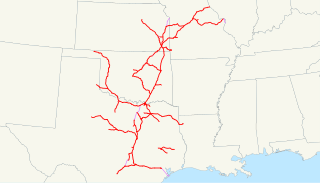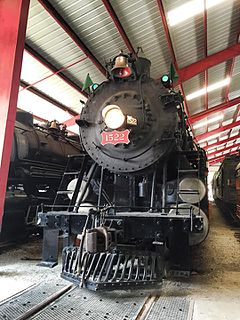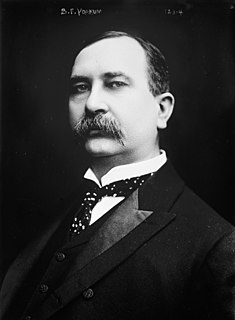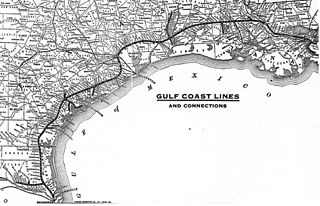Related Research Articles

The Missouri–Kansas–Texas Railway was a Class I railroad company in the United States, with its last headquarters in Dallas, Texas. Established in 1865 under the name Union Pacific Railway, Southern Branch, it came to serve an extensive rail network in Texas, Oklahoma, Kansas, and Missouri. In 1988, it merged with the Missouri Pacific Railroad; today, it is part of Union Pacific Railroad.

The Missouri Pacific Railroad, commonly abbreviated as MoPac, was one of the first railroads in the United States west of the Mississippi River. MoPac was a Class I railroad growing from dozens of predecessors and mergers. In 1967, the railroad operated 9,041 miles of road and 13,318 miles of track, not including DK&S, NO&LC, T&P, and its subsidiaries C&EI and Missouri-Illinois.

The St. Louis–San Francisco Railway, commonly known as the "Frisco", was a railroad that operated in the Midwest and South Central United States from 1876 to April 17, 1980. At the end of 1970, it operated 4,547 miles (7,318 km) of road on 6,574 miles (10,580 km) of track, not including subsidiaries Quanah, Acme and Pacific Railway and the Alabama, Tennessee and Northern Railroad; that year, it reported 12,795 million ton-miles of revenue freight and no passengers. It was purchased and absorbed into the Burlington Northern Railroad in 1980. Despite its name, it never came close to San Francisco.
The Alabama, Tennessee and Northern Railroad was a short line railroad which operated in the state of Alabama. The company grew from an acquisition of an existing logging railroad in 1897, and merged with the St. Louis–San Francisco Railway in 1971. The company was also known as the "Port of Mobile Route."
The Kansas City, Clinton and Springfield Railway, also known as the Leaky Roof Railway, is a now abandoned rail line that ran from Olathe, Kansas, near Kansas City, through Clinton, Missouri, and on to Ash Grove, Missouri, where it tied in with the Kansas City, Fort Scott and Memphis Railway, later the Frisco Railroad. A short branch line served Pleasant Hill, Missouri. It was founded in 1884, as a subsidiary of the KCFS&G; on February 12, 1885, the railroad was incorporated in Missouri. The line was later bought by the Frisco in 1928. After consolidation with the Frisco, the route was deemed redundant to the parallel and better constructed Frisco "Highline". Seeking to cut costs, the Frisco chose to abandon the line in 1934. Because it ran parallel to the Frisco's Highline, the two railroads intersected at many places. Thus, the Frisco chose to consolidate the two lines into one by keeping the track of whichever railroad had the favorable route between these numerous crossings. The less favorable sections were then removed. Service continued over these portions of the line with a daily except Sunday local until the mid-1970s, when dam construction and bridge fires ended through service on the route between Kansas City and Springfield, Missouri. Operating for a while as a North and South branch line, services were cut and the line was, section by section, successively abandoned. Although the rails are now gone, traces can be found along Route 7 and Route 13, however along most sections, little remains to be seen.

The Meteor was a named passenger train operated by the St. Louis-San Francisco Railway. It ran overnight between Oklahoma City and St. Louis via Tulsa and was later extended to Lawton, Oklahoma on July 18, 1955. The name was shared with a branch line Meteor running between Monett, Missouri, and Paris, Texas. Later this line was truncated to terminate at Fort Smith, Arkansas.

St. Louis–San Francisco Railway 1522 is a two-cylinder, simple class T-54 4-8-2 "Mountain" type steam locomotive built in 1926 by the Baldwin Locomotive Works for the St. Louis–San Francisco Railway (SLSF), also known as the "Frisco". It was retired by the Frisco in 1951 and in May 1959 donated to the National Museum of Transportation in St. Louis, Missouri, where it is currently on display. It was restored to operating condition in the spring of 1988 and operated in excursion service until the fall of 2002 when it was placed back into retirement at the museum.
Article X of the Texas Constitution of 1876 covers railroad companies and the creation of the Railroad Commission of Texas. The federal government later created the Interstate Commerce Commission to regulate railroads, and eight of the nine sections of Article X were repealed in 1969 as "deadwood".

St. Louis–San Francisco 4018 is a class USRA Light 2-8-2 "Mikado" steam locomotive which operated for three decades hauling freight between Bessemer and Birmingham, Alabama, on the St. Louis–San Francisco Railway. It went on display at the Alabama State Fairgrounds in 1952 and is one of only a few locomotives of its type that survive.

Benjamin Franklin Yoakum was an American railroad executive of the late 19th and early 20th centuries who attempted to join the Frisco and Rock Island Railroads into a great system stretching from Chicago to Mexico. In 1909, when Yoakum controlled 17,500 miles of railroad, Railway World magazine called him an "empire builder" who had done as much for the Southwest as legendary James J. Hill had done for the Northwest.
The following is a brief history of the North American rail system, mainly through major changes to Class I railroads, the largest class by operating revenue.
The following is a brief history of the North American rail system, mainly through major changes to Class I railroads, the largest class by operating revenue.

St. Louis–San Francisco 4003 is a 2-8-2, Mikado type, standard gauge steam railway locomotive built by the American Locomotive Company in 1919 as a standard USRA Light Mikado for the Pennsylvania Railroad. The PRR, for unknown reasons, rejected 33 of 38 locomotives in the order. The United States Railroad Administration reassigned 23 of them to the St. Louis–San Francisco Railway (SLSF), also known as the "Frisco". The Frisco also received 10 sisters from the Indiana Harbor Belt Railroad, making 33 in all. The locomotive is now on display at the Fort Smith Trolley Museum in Fort Smith, Arkansas.

Chartered on June 6, 1903, the St. Louis, Brownsville & Mexico Railway was a 200-mile (321 km) U.S. railroad that operated from Brownsville, Texas, to Gulf Coast Junction in Houston, Texas. It served numerous towns and cities along its routes and operated a rail bridge between Brownsville and Matamoros, Tamaulipas, in junction with the Mexican government. The Brownie connected the citizens of Brownsville to nearby Corpus Christi for the first time on land rather than using water transportation.
St. Louis–San Francisco 1352 is an Alco built 2-8-2 Steam locomotive. Built in 1912 as a 2-8-0 Consolidation-type by the American Locomotive Company of Schenectady, New York, for the St. Louis–San Francisco Railway, the engine was later rebuilt into a 2-8-2 Mikado-type to keep up with the traffic demands around World War II. After being retired from the Frisco, the locomotive was moved to many locations under several owners, until it ended up in a small engine house in Rural, Illinois. The locomotive was disassembled by a group with the intent to restore it. The American Steam Railroad ("ASR") was founded, and they purchased No. 1352 in 2008 to restore the locomotive to operating condition. Currently the locomotive sits partially disassembled in Taylorville, Illinois ASR plans to move No. 1352 to Cleveland Ohio to be restored, after Reading 2100 is finished. As of July of 2022, the locomotive remains in Taylorville.

The Gulf Coast Lines was the name of a railroad system comprising three principal railroads, as well as some smaller ones, that stretched from New Orleans, Louisiana, via Baton Rouge and Houston to Brownsville, Texas. Originally chartered as subsidiaries of the Frisco Railroad, the system became independent in 1916 and was purchased by the Missouri Pacific Railroad in 1925.

St. Louis–San Francisco Railway locomotive 4500 is a 4-8-4 Northern type steam engine.
The Paris and Great Northern Railroad (“P&GN”), a wholly-owned subsidiary of the St. Louis–San Francisco Railway (“SLSF”), was incorporated July 28, 1881 for the purpose of building a railroad from Paris, Texas to a connection with the SLSF at the Red River. Work commenced in February 1886, and the line--which included a bridge over the Red River--was placed in operation in January of 1888. The mainline stretched 16.210 miles, the railroad also having 8.337 miles of yard tracks and sidings, for 24.547 miles total. The line was operated directly by the SLSF until September 1, 1902, after which the P&GN operated it, except during World War I when it was operated by the United States Railroad Administration. On June 1, 1928, the railway was merged into another SLSF entity, the St. Louis, San Francisco and Texas Railway Company (“SLSF&T”).
References
- Lewis, Robert G. Handbook of American Railroads. New York: Simmons-Boardman Publishing Corporation, 1951, pp. 19–5.